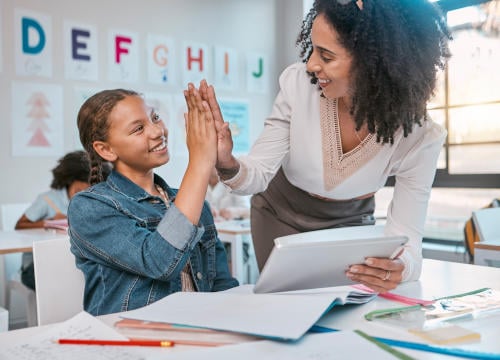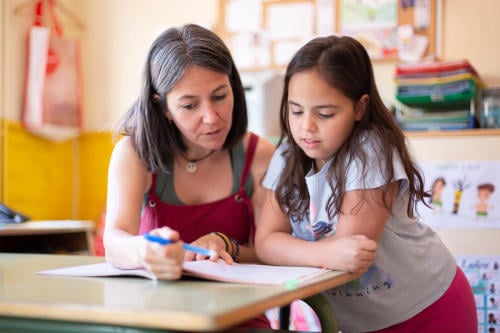Dyslexia is a common learning difference which affects how individuals process language and can make reading and writing more challenging. Ten per cent of the UK population is believed to be dyslexic, according to the British Dyslexia Association. Dyslexia translates as ‘difficulty with words’ (from dys, meaning impaired or difficult, and lexia, meaning word or speech).
Most often, dyslexia impacts reading, writing and spelling, but it can also influence other areas of learning and behaviour. For example, children with dyslexia can also experience challenges with their executive function skills, such as organisation, working memory and following instructions.
Last week was Dyslexia Awareness Week (6-10 October), so we thought it would be fitting to share strategies for identifying dyslexia as early as possible. We will also provide actionable ways to support dyslexic children.
Why is Early Intervention Important for Children with Dyslexia?

Early intervention for dyslexia gives children the chance to thrive, both academically and emotionally.
“If dyslexia is identified and addressed early, pupils can receive the support and accommodations they need to succeed in school and in life.” https://www.supportingeducation.com/content-hub/early-identification-of-dyslexia-what-difference-does-it-make/
Many successful individuals have dyslexia. However, without early identification and support, dyslexia can impact a child’s self-esteem, educational attainment and long-term employment outcomes.
The brain changes rapidly in early childhood. When dyslexia is highlighted early, interventions can be put in place to support the child’s well-being and development throughout their education journey.
Identifying Dyslexic Students in Schools

Identifying signs of dyslexia in children early helps their teachers provide timely, tailored and effective support.
According to SEN tutor Sarah, “It is crucial to get the right diagnosis as early as possible. I am working with two pupils that were diagnosed with dyslexia quite late (while they were studying Key Stage 4). Since their dyslexia diagnoses, their opportunities to learn have broadened significantly. They can now access the learning materials more easily as they are presented in a way which suits their needs.”
A formal assessment is necessary to diagnose a child with dyslexia, but before that can happen, teachers need to be aware of the signs in their pupils.
But what exactly should teachers be looking for?
Key pre-screening questions for dyslexia

- Can this child read phase one sounds?
- Can they blend them to create a word?
- Can they link letters with sounds?
- Are they learning to read at the pace you would expect?
- When reading, do they often pause, or stop and start?
- Are they learning how to spell frequently used words?
- Is there dyslexia in the family? (parents or siblings)
The questions above are designed for early intervention. If considering older children, simply adapt these questions to their current education level; for example:
- Does the child have difficulty following verbal or written instructions?
- Do they struggle to maintain concentration?
- Do they have illegible or untidy handwriting?
- Do they read relatively slowly?
- Are they avoiding schoolwork?
- Do they get upset or frustrated during lessons?
- Do they persistently make spelling errors?
- Have you noticed them skipping or muddling letters, such as b and d?
How Teachers Can Support Pupils with Dyslexia

Whilst a formal diagnosis of dyslexia is typically made by a specialist, teachers play a vital role in recognising early warning signs of dyslexia. Teachers can make the classroom more inclusive with practical dyslexia support strategies. Small adjustments can make a big difference:
Checking in: Ask the child how they are feeling and what help they need.
Modifying tasks and adding structure: Amend tasks so that they are presented in a very structured, step-by-step format. Work quantities should be reduced, or the child should be given extra time to complete tasks.
Multi-sensory learning: Combine visual, auditory and tactile learning methods.
SEN Tutor Sophia, shares a great example of this strategy: “Instead of just looking at words on a page, we might say the sound out loud while writing the letter in sand, or using our fingers to trace it on different textures. It is simple, but really effective for the memory.”
Incorporate assistive tools: Utilise text-to-speech software, audiobooks, or other devices designed to alleviate reading challenges and help dyslexic children build up their confidence.
Celebrate each success: Embrace the small milestones, as this will encourage the child throughout their learning journey. Don’t focus on how far there is to go, without reflecting on how far the child has already come.
Promote positivity: Help dyslexic pupils feel optimistic about learning and their future success.
How Parents Can Help Children with Dyslexia at Home

Parents are the keystone of support for dyslexic children. Parents looking for help for children with dyslexia can try these supportive strategies at home:
Identify early concerns: Speak with your child’s teacher or school SENDCO if you notice any learning difficulties.
Use structured literacy programmes: This method teaches a child to read in a clear, organised way. It focuses on basic skills, such as grasping sounds, connecting letters to sounds (phonics), decoding words, spelling words, and understanding how words are built.
Encourage multi-sensory reading: Engaging more than one sense (touch, hearing, sight, etc.) can have a powerful impact on a dyslexic child’s reading journey.
As Sophia explains, “Combining senses — speaking, seeing and touching — helps words stick. Simple, practical techniques make learning fun and effective.”
Simplify reading tasks or use audiobooks: Choose shorter texts, take turns reading, or use audiobooks to reduce fatigue and anxiety. Some dyslexic children have trouble verbalising words, so audiobooks can reduce the need to multitask. Hearing how words are supposed to sound can also help.
Sophia highlights another example of reading modifications: “Reading together works well, too. Sometimes we take turns, or I read a line first and my pupil echoes it. It builds confidence and takes some of the pressure off. I always try to keep texts short and break things down, so it doesn’t feel too overwhelming. Tools like ‘Nessy’ or just having a device that reads text aloud can be very empowering for them.”
Build confidence through praise, persistence and patience: Focus on your child’s progress. They might have to work extra hard, but that doesn’t mean they are failing. In fact, they should be praised for their determination and resilience, because sticking at something you think you are bad at can feel demoralising.
Early intervention isn’t just about teaching reading – it’s about empowering children with dyslexia to become confident, capable learners. By recognising the signs early and providing appropriate support, we can help them reach their full potential.
At SENsational Tutors, our specialist dyslexia tutors provide personalised, multisensory learning and holistic approaches to help every child succeed.
Useful Websites
https://www.dailymail.co.uk/health/article-134957/How-spot-dyslexia-child.html
https://www.learningwithdyslexia.org/post/10-strategies-for-supporting-dyslexic-learners
Please note: The information provided within this blog, by SENsational Tutors, is for general information purposes only. We appreciate that every person is unique and any advice/experiences mentioned within the content of each blog may not be reflective of your own personal experience. All information on the site is provided in good faith and is for educational and informational purposes only. It is not a substitute for professional advice. Before taking any actions based upon such information, we encourage you to consult with appropriate professionals.



